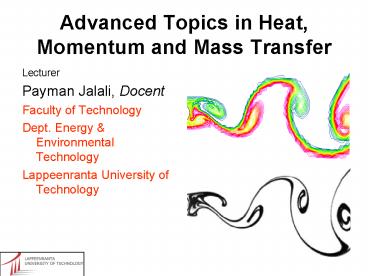Advanced Topics in Heat, Momentum and Mass Transfer PowerPoint PPT Presentation
1 / 20
Title: Advanced Topics in Heat, Momentum and Mass Transfer
1
Advanced Topics in Heat, Momentum and Mass
Transfer
- Lecturer
- Payman Jalali, Docent
- Faculty of Technology
- Dept. Energy Environmental Technology
- Lappeenranta University of Technology
2
Introduction to advanced simulation methods
(stochastic and deterministic models) Computer
simulations in fluid mechanics and heat transfer
are not limited to well-known methods of
finite-difference, finite-volume, finite-element
and so on. There are some other advanced methods
of simulations which are basically made for
discontinuous systems. For example, materials
properties and some specific behaviors can be
calculated using molecular dynamics simulations
(deterministic) or Monte-Carlo simulations
(stochastic). These simulations constitute new
approach for studying different materials.
3
- Monte Carlo Methods
- These methods deal with some sampling experiments
in which random numbers are generated to satisfy
certain physical conditions as the ultimate goal.
These operations are well suited to a computer. - Starting example The problem of Hit Miss
4
Stochastic models Monte Carlo methods are also
called stochastic models since the calculations
are performed via rejection or acceptance of
random numbers based on certain conditions in the
problem. How can we calculate the integral of a
function just by producing random
numbers? Remember that the integral of a function
f is the area below f limited to xy axes.
If you can randomly hit only the area of
rectangle specified by SR some of the shots will
hit S1 and the rest will hit outside it. The
ratio of the shots hit S1 to the total number of
shots will approach the ratio of S1/SR if our
shots are random and infinite.
5
Application of MC simulation in radiation
problems Monte Carlo methods have been used in a
wide range of scientific and engineering
problems. One of such applications is in
calculation of the fraction of emitted photons
from a point that is absorbed in another point.
The fraction of total energy emitted from A and
absorbed by A either directly or after any
number and type of reflections. Therefore, one
needs to shoot Ni bundles of energy from A and
find Nij bundles which are absorbed by A.
Random numbers which can be generated and
considered to determine the emitted and received
(absorbed) photons correspond to point of
emission (emitting source point), wavelength of
emission, direction of emission (angles of
emission), absorption or reflection, reflection
directions (if not absorbed)
6
Calculation of generalized exchange factor F1-2
in radiation problems using Monte Carlo
method This example shows the formulation and
computer algorithm for two identical parallel
disks using MC algorithm.
- Different stages of the problem which need
random number generation are as follows - Point of emission for the energy bundle on
surface A - Direction of emission for the energy bundle
- Absorption of the bundle by surface A
- Reflection of the bundle (specular or diffuse)
- Direction of reflection
Surface properties
7
(No Transcript)
8
Point of emission for the energy bundle on
surface A
Note that we assume isothermal surfaces (constant
temperature), otherwise the point of emission
would be also dependent on temperature. Random
numbers (uniformly distributed between 0 and 1)
representing radial and angular position of
emission must be consistent with
9
Direction of emission for the energy bundle
Total spectral emissive power
Azimuthal (?) and polar (?) directions of
emission
For isotropic surface we have
So,
10
The emission direction and the position vector of
the emitted bundle
The position vector of a bundle traveled by a
length of A will be
(I)
11
Absorption of the bundle by surface A
12
Reflection of the bundle (specular or diffuse)
If the ray is reflected, we need to determine
whether the reflection is specular (like a
mirror) or diffuse (random). Thus we need to
generate another random number
13
The reflection direction and the position vector
of the reflected bundle
The reflected ray will be in the level of the
lower plate when
(II) for reflection
(I) for emission
14
A bundle of energy may reflect several times
before it is escaped or absorbed. We need a
constant formulation for traveling a photon
between the two disks. Comparing (I) and (II)
leads us to the following methodology.
15
(No Transcript)
16
Ti, j
Two dimensional heat conduction in a cylinder
Ti1, j
Ti, j1
Ti, j-1
One quarter of a cylinder is shown in the
following figure. A) Central node (Tm,1) For
this node we can consider the governing equation
of conduction in cylindrical coordinates which is
as follows
Tm,1
Te,f
rj
Ti-1, j
R
h Tinf
The second term in this equation should be
treated when r goes to zero. It can be written as
17
This limit is 0/0 and we can apply the Hospital
rule to evaluate this limit
So the PDE will be as follows
Now we may discretize this equation around a
point located on the symmetry axis of cylinder
18
Because of the symmetry at the centerline, we can
write
so one can write the difference equation of node
i,j as
By changing the parameters to dimensionless form
by introducing the following dimensionless
variables
yields that,
19
For the points on the centerline we have j1
and if substitute i by m then the final form of
FD equation of centerline node can be written
B) Interior node (Ti,j)
20
(No Transcript)

